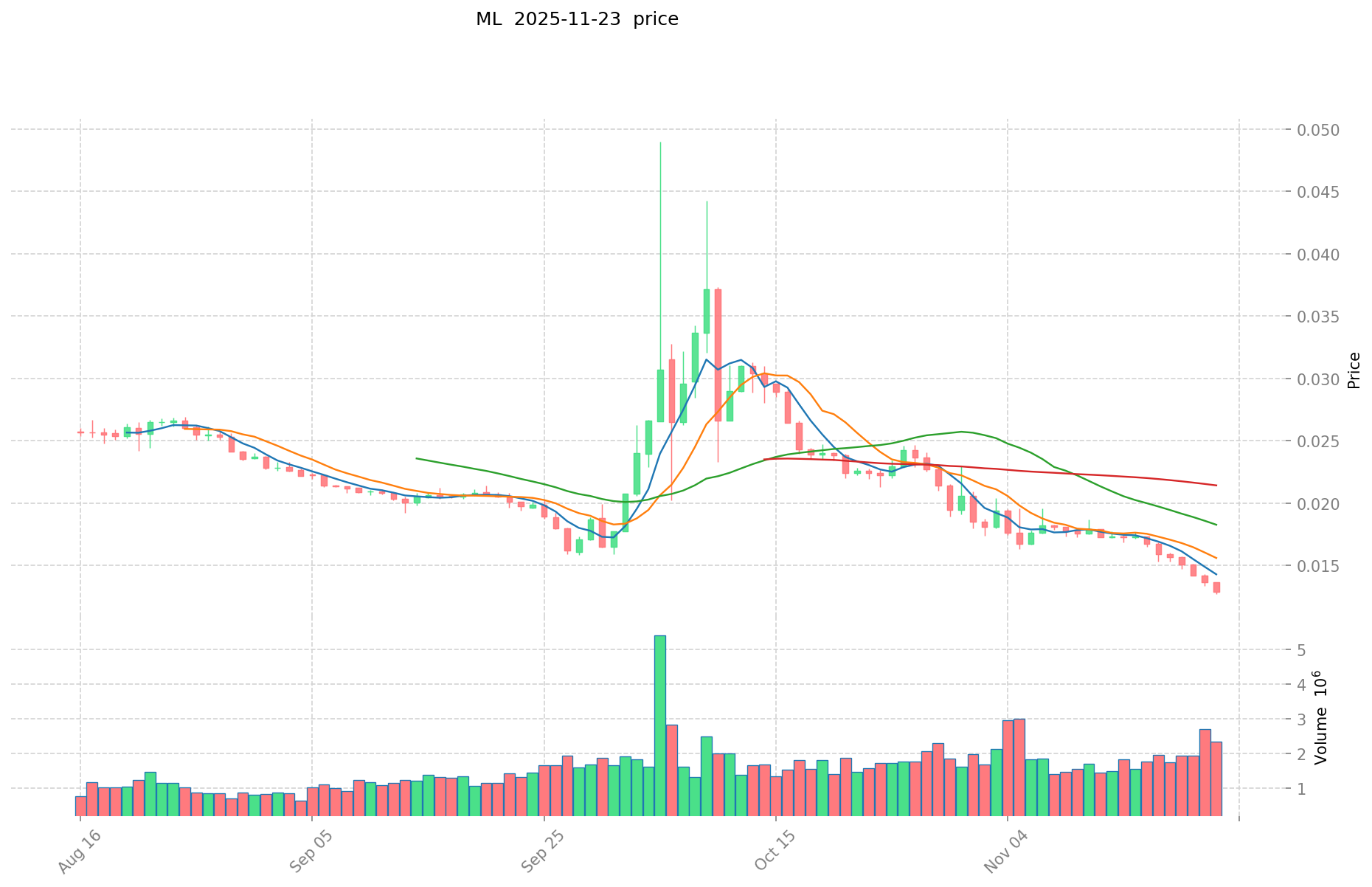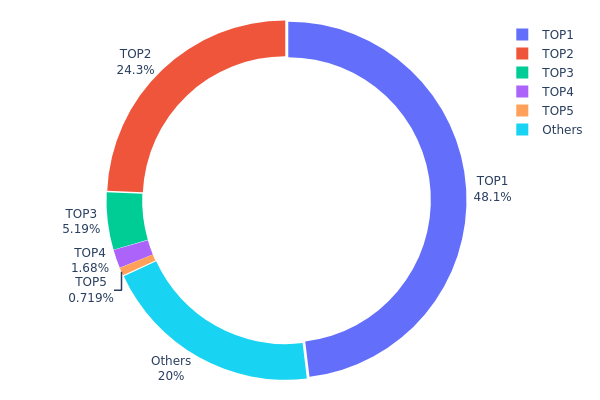2025 ML Price Prediction: The Future of Machine Learning Costs and Market Trends
Introduction: ML's Market Position and Investment Value
Mintlayer (ML), as a layer 2 protocol for decentralized finance on Bitcoin, has made significant strides since its inception. As of 2025, Mintlayer's market capitalization stands at $2,696,441, with a circulating supply of approximately 206,941,027 tokens, and a price hovering around $0.01303. This asset, often referred to as the "Bitcoin DeFi enabler," is playing an increasingly crucial role in expanding the capabilities of native Bitcoin for decentralized finance applications.
This article will comprehensively analyze Mintlayer's price trends from 2025 to 2030, considering historical patterns, market supply and demand, ecosystem development, and macroeconomic factors to provide investors with professional price predictions and practical investment strategies.
I. ML Price History Review and Current Market Status
ML Historical Price Evolution
- 2024: Project launch, price reached all-time high of $0.99989
- 2025: Market downturn, price dropped to all-time low of $0.0122
ML Current Market Situation
As of November 24, 2025, Mintlayer (ML) is trading at $0.01303, with a 24-hour trading volume of $31,148.21. The token has seen a 1.39% increase in the last 24 hours, but it's down 22.53% over the past week and 41.04% over the last month. ML's current market capitalization stands at $2,696,441.58, ranking it at 1973 in the global cryptocurrency market.
The token's circulating supply is 206,941,027.17 ML, which represents 34.49% of its total supply of 400,000,000 ML. The fully diluted market cap is $5,212,000. Despite the recent positive 24-hour performance, ML is experiencing a significant downturn compared to its all-time high of $0.99989 reached on January 11, 2024, currently trading 98.7% below that peak.
The market sentiment for cryptocurrencies overall is currently in a state of "Extreme Fear" with a VIX of 13, indicating a highly cautious and pessimistic outlook among investors.
Click to view the current ML market price

ML Market Sentiment Indicator
2025-11-23 Fear and Greed Index: 13 (Extreme Fear)
Click to view the current Fear & Greed Index
The crypto market is experiencing extreme fear, with the sentiment index plummeting to 13. This level of pessimism often signals a potential buying opportunity for contrarian investors. However, caution is advised as market volatility may persist. Traders on Gate.com should consider diversifying their portfolios and implementing risk management strategies. Remember, market sentiment can shift rapidly, so stay informed and make decisions based on thorough analysis rather than emotion.

ML Holdings Distribution
The address holdings distribution for ML reveals a highly concentrated ownership structure. The top address holds a substantial 48.10% of the total supply, followed by the second-largest holder with 24.28%. Together, these two addresses control nearly three-quarters of all ML tokens. The top five addresses collectively account for approximately 80% of the total supply, leaving only about 20% distributed among other holders.
This level of concentration raises concerns about the token's decentralization and market stability. With such a significant portion of ML tokens held by a few addresses, there's an increased risk of price manipulation and volatility. Large holders could potentially influence market dynamics through substantial buy or sell orders. Moreover, this concentration may impact governance decisions if ML employs a token-based voting system, potentially compromising the project's decentralized ethos.
The current distribution suggests a nascent or tightly controlled ecosystem, which may be indicative of early-stage projects or those with strong institutional backing. However, for long-term sustainability and broader market participation, a more distributed token allocation would be preferable to mitigate risks and enhance market resilience.
Click to view the current ML Holdings Distribution

| Top | Address | Holding Qty | Holding (%) |
|---|---|---|---|
| 1 | 0x0599...434cc6 | 192402.39K | 48.10% |
| 2 | 0xe03a...ea283f | 97130.78K | 24.28% |
| 3 | 0x9642...2f5d4e | 20767.96K | 5.19% |
| 4 | 0x0d07...b492fe | 6732.71K | 1.68% |
| 5 | 0x3e4e...f39f89 | 2875.35K | 0.71% |
| - | Others | 80090.80K | 20.04% |
II. Key Factors Affecting ML's Future Price
Supply Mechanism
- Halving: The ML network undergoes periodic halving events, reducing block rewards for miners.
- Historical Pattern: Previous halvings have typically led to price increases due to reduced supply inflation.
- Current Impact: The upcoming halving is expected to potentially drive price appreciation, assuming historical patterns hold.
Macroeconomic Environment
- Monetary Policy Impact: Major central banks' policies, particularly those of the Federal Reserve, can influence ML's price through their effect on risk assets.
- Inflation Hedge Properties: ML has shown some characteristics of an inflation hedge, potentially benefiting from high inflation environments.
- Geopolitical Factors: Global political tensions and economic uncertainties may increase ML's appeal as a decentralized store of value.
Technological Development and Ecosystem Building
- Layer 2 Solutions: Ongoing development of Layer 2 scaling solutions aims to improve ML's transaction speed and reduce fees.
- Smart Contract Functionality: Advancements in smart contract capabilities on the ML network could expand its use cases and attract more developers.
- Ecosystem Applications: Decentralized finance (DeFi) platforms and non-fungible token (NFT) projects built on ML continue to grow, potentially driving network adoption and value.
III. ML Price Prediction for 2025-2030
2025 Outlook
- Conservative prediction: $0.00806 - $0.01
- Neutral prediction: $0.01 - $0.013
- Optimistic prediction: $0.013 - $0.01352 (requires favorable market conditions)
2027-2028 Outlook
- Market stage expectation: Potential growth phase
- Price range forecast:
- 2027: $0.01371 - $0.02088
- 2028: $0.01422 - $0.0206
- Key catalysts: Increased adoption and technological advancements
2030 Long-term Outlook
- Base scenario: $0.02076 - $0.02281 (assuming steady market growth)
- Optimistic scenario: $0.02281 - $0.02943 (assuming strong market performance)
- Transformative scenario: Above $0.02943 (with exceptional market conditions and widespread adoption)
- 2030-12-31: ML $0.02281 (75% increase from 2025)
| 年份 | 预测最高价 | 预测平均价格 | 预测最低价 | 涨跌幅 |
|---|---|---|---|---|
| 2025 | 0.01352 | 0.013 | 0.00806 | 0 |
| 2026 | 0.0179 | 0.01326 | 0.00809 | 1 |
| 2027 | 0.02088 | 0.01558 | 0.01371 | 19 |
| 2028 | 0.0206 | 0.01823 | 0.01422 | 39 |
| 2029 | 0.02621 | 0.01941 | 0.01631 | 48 |
| 2030 | 0.02943 | 0.02281 | 0.02076 | 75 |
IV. Professional Investment Strategies and Risk Management for ML
ML Investment Methodology
(1) Long-term Holding Strategy
- Suitable for: Risk-tolerant investors with a long-term perspective
- Operational suggestions:
- Accumulate ML tokens during market dips
- Set price targets and take partial profits
- Store tokens in a secure non-custodial wallet
(2) Active Trading Strategy
- Technical analysis tools:
- Moving Averages: Identify trend directions and potential reversal points
- Relative Strength Index (RSI): Gauge overbought/oversold conditions
- Key points for swing trading:
- Monitor Bitcoin price movements as they may impact ML
- Set stop-loss orders to limit potential losses
ML Risk Management Framework
(1) Asset Allocation Principles
- Conservative investors: 1-3% of crypto portfolio
- Aggressive investors: 5-10% of crypto portfolio
- Professional investors: Up to 15% of crypto portfolio
(2) Risk Hedging Solutions
- Diversification: Spread investments across multiple crypto assets
- Stop-loss orders: Implement to limit potential losses
(3) Secure Storage Solutions
- Hot wallet recommendation: Gate web3 wallet
- Cold storage solution: Hardware wallet for long-term holdings
- Security precautions: Enable two-factor authentication, use strong passwords
V. Potential Risks and Challenges for ML
ML Market Risks
- High volatility: ML price may experience significant fluctuations
- Liquidity risk: Limited trading volume may impact ability to buy/sell
- Correlation with Bitcoin: ML performance may be influenced by BTC price movements
ML Regulatory Risks
- Uncertain regulatory landscape: Potential for new regulations affecting layer 2 protocols
- Cross-border compliance: Varying regulations across jurisdictions may impact adoption
- Tax implications: Evolving tax laws may affect ML transactions and holdings
ML Technical Risks
- Smart contract vulnerabilities: Potential for exploits or bugs in the protocol
- Scalability challenges: Ability to handle increased transaction volume
- Interoperability issues: Compatibility with other blockchain networks and protocols
VI. Conclusion and Action Recommendations
ML Investment Value Assessment
Mintlayer offers a unique value proposition as a layer 2 solution for Bitcoin, but faces significant short-term risks due to market volatility and regulatory uncertainty. Long-term potential exists if the project can successfully integrate with the Bitcoin ecosystem and attract widespread adoption.
ML Investment Recommendations
✅ Newcomers: Start with small, regular investments to build a position over time
✅ Experienced investors: Consider a moderate allocation with active risk management
✅ Institutional investors: Conduct thorough due diligence and consider ML as part of a diversified crypto portfolio
ML Trading Participation Methods
- Spot trading: Buy and sell ML tokens on Gate.com
- Dollar-cost averaging: Set up recurring purchases to build a position over time
- Staking: Participate in staking programs if available to earn additional rewards
Cryptocurrency investments carry extremely high risk. This article does not constitute investment advice. Investors should make decisions carefully based on their own risk tolerance and are advised to consult professional financial advisors. Never invest more than you can afford to lose.
FAQ
Can ML predict stock prices?
ML can analyze patterns but can't guarantee accurate stock price predictions due to market complexity and unpredictable factors.
What is a prediction in ML?
A prediction in ML is an algorithm's estimate of future outcomes or values based on historical data and patterns. It uses trained models to forecast trends or make decisions.
Can Chatgpt 4 predict stocks?
No, ChatGPT 4 cannot accurately predict stocks. It's an AI language model, not a financial forecasting tool.
Which AI is best for stock price prediction?
For stock price prediction, advanced machine learning models like LSTM, transformer-based architectures, and ensemble methods are considered most effective.
Share
Content